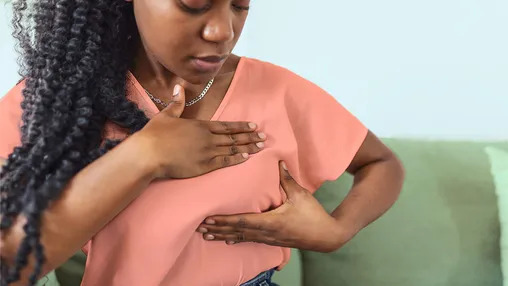
Seeing your doctor routinely for breast cancer screening is one great way to reduce your risk. Still, some women may notice changes in their breasts’ size, contour, or appearance between visits.
Tell your doctor whether you have any lumps or changes in your breasts; it’s smart. Some breast tumors are evident simply from glancing in the mirror or from daily activities. Early detection of cancer facilitates treatment.
Asymmetry
Generally speaking, the left breast is more prone to get cancer than the right. When it does, the cancer can be more aggressive. According to a study in the Journal of the American Association for Cancer Research, left breast cancer incidence is 20% greater.
Although breast asymmetry is not usually a symptom of cancer, it is worth investigating if one breast seems considerably different in size or shape than the other.
Breast Flaky Skin
A warning clue could be red, flaky, thick, or dry skin on the breast or nipple. Under their breasts, some women with breast cancer see peeling or scaling. Though skin disorders like eczema might also present these symptoms, it is still advisable to contact a doctor.
These changes can occasionally indicate Paget’s disease, a rare type of breast cancer affecting less than 4% of individuals, according to the National Cancer Institute. Unlike most breast tumors, Paget’s disease develops on the skin rather deep into the breast.
It often affects just one breast and may come and go. Signs can include:
- Red, flaky, or dry skin
- Peeling skin
- Thickened skin or nipple
- Itching or tingling around the nipple or areola
- Yellow or bloody nipple discharge
- A flat or inward-turning nipple
Redness or Rash on the Breast
Redness or a rash may be a sign of inflammatory breast cancer, a rare but serious form of cancer. It happens when cancer cells block the lymph vessels, causing swelling and redness.
Only about 15% of people with inflammatory breast cancer find a lump, and it doesn’t always show up on a mammogram. It’s often mistaken for an infection or skin condition. See a doctor if you notice any of these signs, as this cancer spreads fast.
Breast Skin with an Orange Peel Look
If your breast skin looks bumpy or thick like an orange peel, see a doctor right away. This could be a sign of infection or Paget’s disease.
Usually treatable with surgery such a mastectomy or lumpectomy, Paget’s discovered early can be According to the National Cancer Institute, Paget’s disease-stricken American women had a five-year survival rate of 82.6% between 1988 and 2001.
Nipple Outlet
Women who are not pregnant or nursing seldom have nipple discharge. If you do see discharge, though, especially if it is crimson, clear, or pus-containing, tell your doctor.
Even non-cancerous conditions can cause discharge, but it’s important to check. Discharge that happens in only one breast and keeps coming back could be an early sign of cancer.
Lump in the Breast or Armpit
One of the most common signs of breast cancer is a lump in the breast or under the arm. Lumps may feel like a marble or a small bump under the skin. Some may feel more like a ridge.
They are often hard and may or may not hurt. Doing regular self-exams can help you spot lumps early. If you find one, call your doctor right away. Early diagnosis can lead to better outcomes.
Breast Dimpling
Dimpling on the breast skin may be a sign of invasive lobular carcinoma (ILC), a common type of breast cancer. It can be hard to tell dimpling from stretch marks, but any change in the skin should be looked at.
ILC is the second most common breast cancer after invasive ductal carcinoma (IDC), making up about 10% of cases. It starts in the milk-producing glands and can spread to nearby tissue. ILC is also harder to detect on mammograms. One in five women with ILC may have it in both breasts.
Nipple That Inverts or Changes Direction
If your nipple starts to turn inward or change direction, it could be a sign of breast cancer. Inverted nipples affect about 10 to 20 out of every 100 people. This can also happen with age or due to other harmless causes, but if it’s new or only affects one breast, have your doctor check it out.
The Wall Dermatology Breast Cancer High-Risk Programs
One in eight women will be diagnosed with breast cancer during their lifetime. But some women have a higher risk than others. Risk factors include:
- Family history of breast or ovarian cancer
- Gene mutations (BRCA1, BRCA2, RTPEN, TP53)
- Smoking
- Obesity
- Alcohol use
- Radiation therapy before age 30
- Hormone replacement therapy
- Pregnancy history
- Breastfeeding history
- Early or late menopause
- Lack of physical activity
- Breast tissue changes
- Age
Thanks to new technology in genetics and genomics, high-risk women now have better tools to lower their chances of getting breast cancer.
At Wall Dermatology, our High-Risk Breast Cancer Program offers personalized care for women who are concerned about their risk.
Protect Your Skin with Expert Skin Cancer Care
Early detection is key to treating skin cancer. At Wall Dermatology, we offer expert screenings and advanced treatments to safeguard your skin. If you’re searching for “skin cancer near me,” trust our specialists for personalized care. Schedule your consultation today! Visit Wall Dermatology
